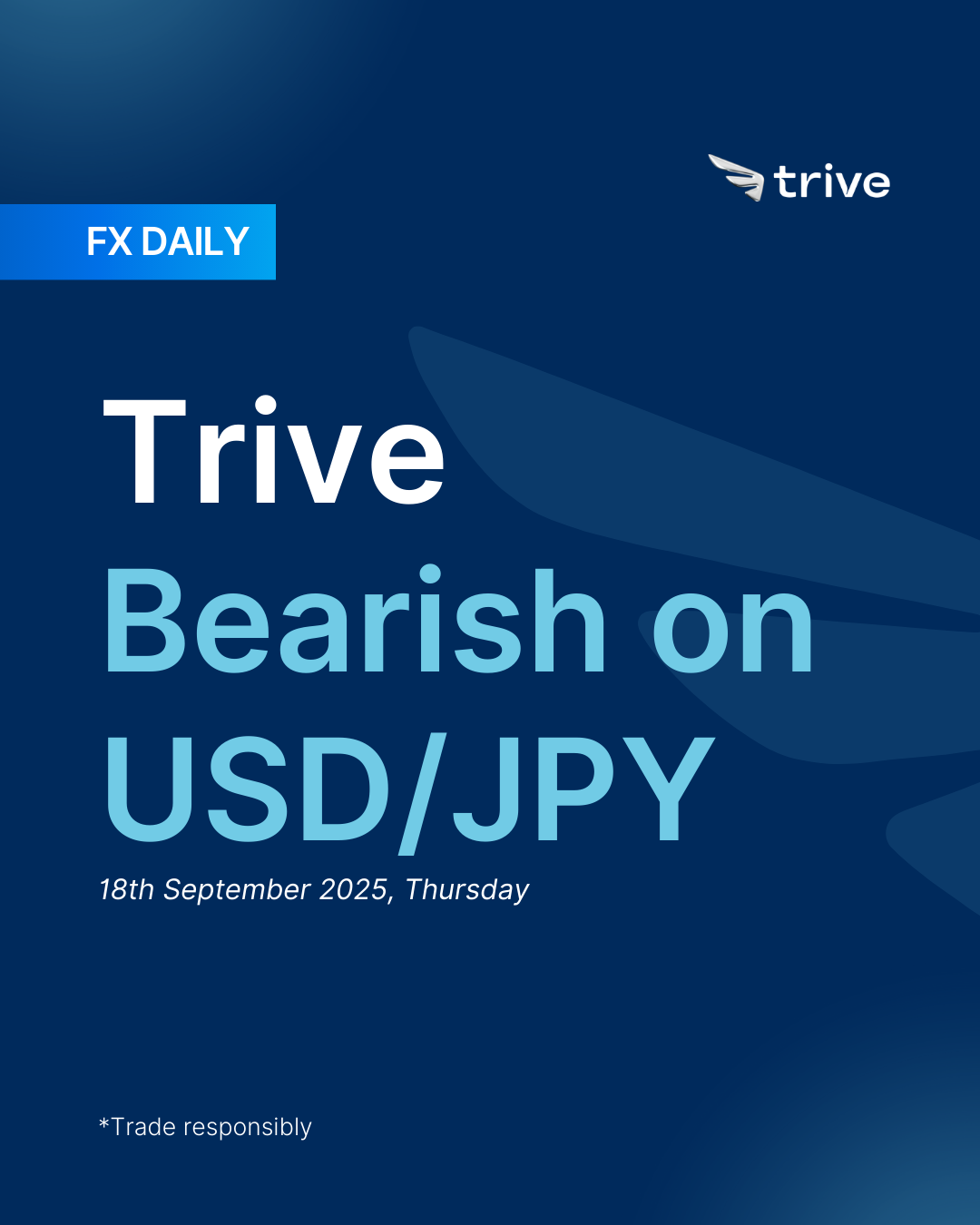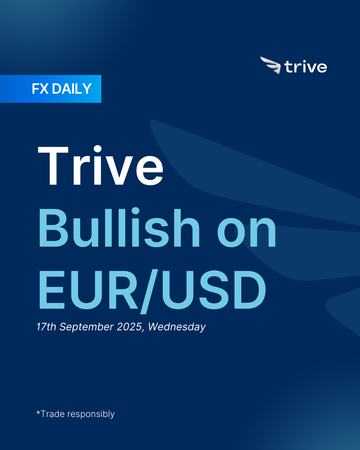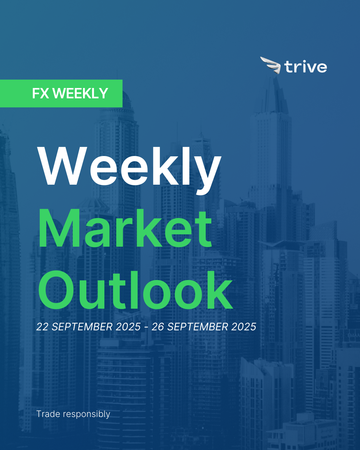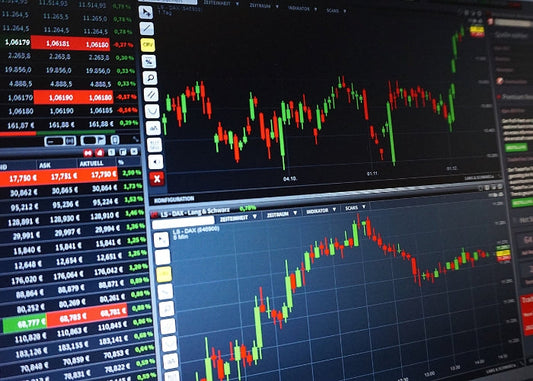FX Daily: Trive Bearish on USD/JPY

The yen whipsawed as Ishiba’s resignation initially drove USD/JPY to 148.57, but hawkish BoJ chatter quickly reversed the move, pulling the pair to 146.30 before consolidating. Markets now see a 62% chance of a BoJ hike by year-end, keeping normalization in play despite political noise. At the same time, weak US labor data and rising Fed cut bets dragged US yields lower. With differentials narrowing and risk sentiment firm, we stay bearish USD/JPY, favoring selling rallies.
JPY: On Hold this week
The Japanese Yen swung violently this week as political turmoil clashed with central bank hawkishness, creating extreme volatility. The week opened with heavy selling after Prime Minister Ishiba unexpectedly announced his resignation. Markets quickly interpreted the political uncertainty as a major setback for the Bank of Japan’s policy normalization, driving USD/JPY to a weekly high of 148.57. But this view was overturned the very next day when a Bloomberg source report suggested some BoJ officials see a rate hike as possible this year, perhaps as early as October. The report triggered a violent reversal, with the Yen surging and USD/JPY plunging more than 200 pips to a weekly low near 146.30. The rest of the week was spent balancing these opposing forces, with the Yen giving back part of its gains as the market settled on the view that while the BoJ remains on a tightening path, political instability could delay the exact timing of the next move.
Politics and central bank expectations were the core drivers. Ishiba’s resignation on Monday initially sent the Yen lower, with markets assuming that fiscal expansion under a new leader would delay BoJ tightening. Money markets even pushed out expectations for the first 25bps hike until April 2026. On Tuesday, however, the Bloomberg source report flipped the narrative entirely. The suggestion that some officials favor an October hike sparked a sharp Yen rally and a steep selloff in JGBs. By week’s end, markets reassessed and concluded that normalization remains intact, though timing is uncertain. Pricing now reflects roughly a 62% chance of a 25bps hike by year-end—lower than the immediate post-report peak but still far more hawkish than at the week’s start.
Economic data was ignored as politics and policy dominated. Even a stronger-than-expected revised Q2 GDP release on Monday failed to move the Yen against the backdrop of Ishiba’s resignation.
Market sentiment reflected the turbulence. USD/JPY had a wild ride, climbing from around 147.50 to 148.57 on Monday before crashing down to 146.31 on Tuesday and later consolidating near 148.00. Japanese Government Bonds also faced pressure, with long-end yields rising on expectations of more fiscal spending and the full curve selling off after the hawkish BoJ headlines. On Friday, a joint US–Japan statement on foreign exchange matters reiterated the standard language of close consultations but had no impact on markets.
The yen whipsawed as political uncertainty met a hawkish hint from the BoJ, leaving markets still leaning to gradual normalization by year end even if the timing is unclear. At the same time, global risk appetite improved and US front end yields eased, a mix that has recently favored higher beta peers over funding currencies like JPY.
Near term, our outlook is weak bearish. External drivers are in charge, with a clear risk on tone encouraging carry and reducing demand for the yen’s safety and funding characteristics even as US yields drift lower. Domestic supports we highlighted last week still matter, including firmer wage momentum and the prospect of measured normalization, but they are not yet strong enough to offset the current global mood. Ordinarily, given narrower differentials and better wage signals, our near term bias would be weak bullish, but the present risk on phase tips us to weak bearish with caution since BoJ communication, Tokyo inflation updates, wage trackers, and shifts in US yields could flip sentiment quickly.
There are a lot of potential catalysts to shift sentiment quickly this week, so we keep caution around the stance and ready to adjust. The BoJ meets this week, and if the tone or credible chatter leans more hawkish than markets expect, we would reassess toward a stronger yen bias; if the meeting proves more dovish or signals further delay, the weak side would likely persist.
Longer term we’re leaning towards a weak bullish stance. Valuation, a slow build in services inflation and wages, and the prospect of gradual policy normalization keep the medium run mix supportive, while eventual Fed easing should narrow differentials further. Japan’s current account surplus and a less one way global rates backdrop also reduce the structural headwind that has weighed on the currency. This view would strengthen if wage gains, core services prices, and front end JGB pricing remain firm together, and would soften if those trends fade or if a renewed US growth lead lifts global yields and revives dollar strength.
USD: 25bp cut by today is expected
The US Dollar was hit hard by a wave of weak economic data that confirmed a rapid deterioration in the US labor market and forced a sharp dovish repricing of Federal Reserve expectations. The DXY began the week on shaky ground, extending its post-NFP decline as markets grew confident in a September rate cut. On Tuesday, a shocking downward revision of 911k to the BLS Benchmark Payrolls initially sent the dollar tumbling, though a strange reversal later stabilized it. That stability did not last. Mid-week, the currency was shaken by a softer-than-expected PPI report, and then decisively by Thursday’s massive spike in Initial Jobless Claims to 263k, the highest since October 2021. This release became the defining event of the week, erasing any lingering belief in labor market resilience and sending the dollar into a steep sell-off. The DXY plunged through the 97.50 level as traders aggressively priced in more Fed cuts, ending a volatile week dominated by the firm turn toward a US slowdown narrative.
The main driver was the collapse in labor market data. Thursday’s Initial Jobless Claims surged to 263k against expectations of 235k, confirming fears of a rapid slowdown. This came after Tuesday’s BLS Preliminary Benchmark Payroll Revision revealed that job growth in the year to March 2025 had been overstated by 911k, showing the labor market was far weaker than previously thought. Inflation data also came in softer. August Producer Prices were much weaker than expected, with both headline and core month-on-month readings falling by 0.1% instead of the forecasted 0.3% rise. The August CPI was mostly in line, but its slightly hotter monthly headline of 0.4% was completely overshadowed by the disastrous jobless claims released at the same time. Confidence added to the negative picture. The preliminary September University of Michigan survey showed the headline sentiment index dropping to 55.4 from an expected 58.0, driven by a sharp fall in expectations. A rise in 5–10 year inflation expectations to 3.9% was noted but largely ignored.
The weak data led to an aggressive repricing of Fed expectations. Fed funds futures shifted to price in 70–73 basis points of easing by year-end, fully pricing in two rate cuts of 25 basis points each and assigning more than an 80% probability of a third cut before the end of 2025. Following the soft PPI report on Wednesday, President Trump renewed his criticism of the Fed, demanding big rate cuts immediately and calling Chair Powell a disaster. The week also began with Trump naming Waller, Warsh, and Hassett as finalists for the Fed Chair role, but by week’s end, reports suggested BlackRock’s Rick Rieder had also become a serious contender. The Fed itself remained in its blackout period before the meeting.
Geopolitical tensions flared as well. Russia–NATO tensions escalated after Russian drones violated Polish airspace, prompting Poland to shoot them down and invoke NATO Article 4 consultations. This marked the first direct engagement between a NATO member and Russian equipment and triggered a strong response from President Trump, who warned of “very hard” sanctions against Russia. The US later proposed broad G7 sanctions on Russian energy. Meanwhile, in the Middle East, tensions spiked after Israel launched an attack targeting a Hamas delegation in Doha, Qatar. The White House confirmed it had been informed in advance, but the move created diplomatic friction with Qatar.
Market sentiment turned firmly toward a US slowdown. While geopolitical risks were elevated, the dollar’s weakness was driven mainly by domestic data. The market adopted a “bad news is good news” stance for assets, with equities and bonds rallying on the prospect of aggressive Fed easing. For the US Dollar, however, bad news was just bad news, as interest rate differentials moved against it and selling pressure intensified. The focus shifted away from hopes of a soft landing and toward concerns of a harder landing that would require a more forceful Fed response.
The dollar slid as a run of weak labor prints, a softer PPI, and the large payroll benchmark revision drove a clear dovish repricing at the front end, with the jump in initial claims to a new cycle high doing the most damage. The same drivers from last week remain in place as the Fed’s focus leans toward employment and front end yields stay heavy, so rallies were sold rather than chased.
Near term we’re bearish. Domestic drivers dominate as the labor picture weakens and markets price earlier and larger easing, which pulls two year yields lower and compresses differentials versus peers that are not easing as quickly. External drivers add weight because risk appetite is stable to firmer and that usually leaves the reserve currency on the back foot unless global growth lurches into outright stress. Trading wise we continue to sell strength into rebounds, and we would dial this down only if the next CPI and wages reaccelerate together, claims retreat decisively, PMIs turn up, or Fed communication reins in the easing path through a lift in front end pricing. Next week the key event will be the FOMC meeting. If the driver mix flips meaningfully or if policy guidance shifts more dovishly than expected, we will reconsider and lean toward a weaker currency until the data and pricing improve. The dollar historically does best when growth and inflation are slowing together or in stagflation, and it underperforms in global expansion phases, so the current mix argues against chasing bounces unless those regime signals change.
Longer term, we shift to weak bearish. We keep a gradual softening bias as the US outperformance premium cools and differentials compress, while the dollar smile framework says the currency tends to fade when global growth stabilizes or broadens and pro cyclical peers lead. Reserve status and safe haven demand can still create countertrend support if global risk sours, but absent a deeper global shock the balance of domestic easing and narrowing spreads should cap the upside. Trading wise we prefer to fade medium horizon rallies and reassess only if a sustained run of firmer CPI and wages lifts the policy path, if PMIs and payrolls strengthen together, or if credit and equity tone rolls over in a way that revives capital preservation flows into the dollar. If the driver mix flips meaningfully or if policy guidance shifts more dovishly than expected, we will reconsider and lean toward a weaker currency until the data and pricing improve. The dollar’s behavior across cycles and its sensitivity to global growth context support this stance.

USD/JPY 4H
Disclaimer
This material is provided for informational purposes only and does not constitute financial, investment, or other advice. The opinions expressed in this material are those of the author and do not necessarily reflect the views of Trive International. No opinion contained in this material constitutes a recommendation by Trive International or its author regarding any particular investment, transaction, or investment strategy. This material should not be relied upon in making any investment decision.
The information provided does not consider the individual investment objectives, financial situation, or needs of any specific investor. Investors should seek independent financial advice tailored to their individual circumstances before making any investment decisions. Trive International shall not be liable for any loss, damage, or injury arising directly or indirectly from the use of this information or from any action or decision taken as a result of using this material.
Trive International may or may not have a financial interest in the companies or securities mentioned. The value of investments may fluctuate, and investors may not get back the amount they originally invested. Past performance is not indicative of future results.
For more information about Trive International, please visit http://trive.com/int
Additional Information
Investing involves risk, including the potential loss of principal. Diversification and asset allocation strategies do not ensure a profit or guarantee against loss. The content in this material is subject to change without notice and may become outdated or inaccurate over time. Trive International does not undertake any obligation to update the information in this material.
By accessing this material, you acknowledge and agree to the terms of this disclaimer. If you do not agree with these terms, please refrain from using this information.
No comments
Home
Trive
TriveHub





0 comments